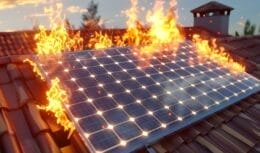
UNESP researchers are advancing in a global research race for the development of pervoskite solar panels. This is a material that offers greater efficiency, which can boost the Brazilian solar energy sector.
A Paulista State University (Unesp) from Bauru is in a worldwide scientific race to produce solar panels with a material called perovskite, which can make large-scale manufacturing more economical and efficient compared to the models that are currently sold. The new technology in the solar energy sector is being studied in research centers in several countries and should result in thinner, lighter and more flexible plates than the current ones, with the potential to contribute to the expansion of non-polluting energy matrices around from all over the world.
Unesp unites 15 researchers to advance in the development of solar panels based on perovskite
In the “competition”, about 15 researchers from the Laboratory of New Materials and Devices at Unesp in Bauru have added their expertise to the knowledge of CSEM Brasil, which is a research institute linked to a company that generates organic and thin solar panels, better known like OPV.
The laboratory is coordinated by professor at the Faculty of Sciences Carlos Graeff, one of the main researchers of the Functional Materials Development Center (CDMF), which aims to create solutions for demands around the world, including the solar energy sector.
According to a report published by the Unesp newspaper, which served to publicize the perovskite study, most of the solar panels used are made of silicon, however, industry and researchers have never stopped looking for alternatives to replace solar energy panels, as silicon is still heavy, reaching around 25 kg per square meter, and also due to high energy consumption.
According to Graeff, the efficiency of conventional solar energy panels, that is, the ability to transform sunlight into electrical energy, is around 15%. Models using perovskite achieved more than 25% efficiency in laboratory tests.
Perovskite is a major competitor of silicon since 2012
According to the professor, what could be observed with perovskite-based solar energy panels was a very rapid and unique technological development in the sector. Now, there is a technological race around the world for various techniques to be tested for the production of energy with the “new” material, with each group testing its own architecture.
Also in 2012, Graeff noted that the efficiency results achieved by perovskite, made it the best “replacement” for silicon solar energy panels.
In 2014, Silvia Letícia Fernandes, who holds a PhD from Unesp on this new material, worked in Switzerland, with a world reference in the development of new technologies for the sector, Michael Gratzel. Silvia stated that during this period, she learned how to assemble Perovskite solar panels and when she finished the internship, she returned to Brazil bringing this new knowledge.
Learn how the Perovskite solar panel is produced
In this architecture, each substance is printed in layer form and performs a cell function. Thus, a flexible and thin film capable of generating electricity through sunlight is generated.
After defending his doctoral thesis, Fernandes continued studying the application of pervoskite, generating interest from CSEM Brasil, which hired him and entered into a partnership with Unesp in Bauru. CSEM Brasil has been working for some years to also improve organic solar cell (OPV) technology.
Mastery over technology and potential efficiency of perovskite motivated CSEM to create a project for the development of a plate that uses both types of material. The research was funded by Petrobras for four years.














Air Force F-16 fighters…
True friend, what they shot down were…
Air Force F-16 fighters…
Well... It's flying scrap... Typical...
Air Force F-16 fighters…
I would like to know what planet you live on…
They discover the third largest deposit…
That’s why all foreigners and NGOs…
Air Force F-16 fighters…
Which genocide are you talking about? Than…
Forests are essential to stabilize global warming…
The search for alternatives to obtain…
These nobio batteries like 6 minutes…
Negative, all combustion engines can…
The war in Ukraine is here to…
The article didn't exactly explain the principle......
Do you speak any of the current languages of…
Several points to be analyzed: Matters…